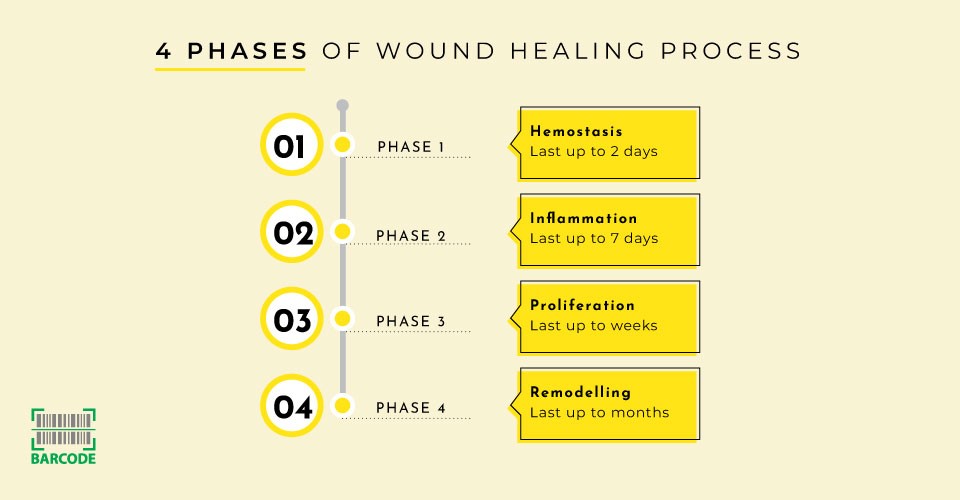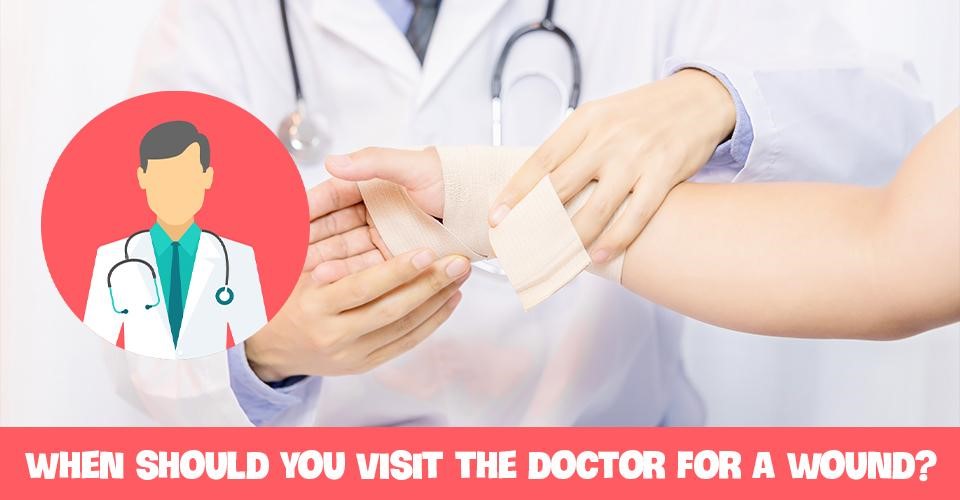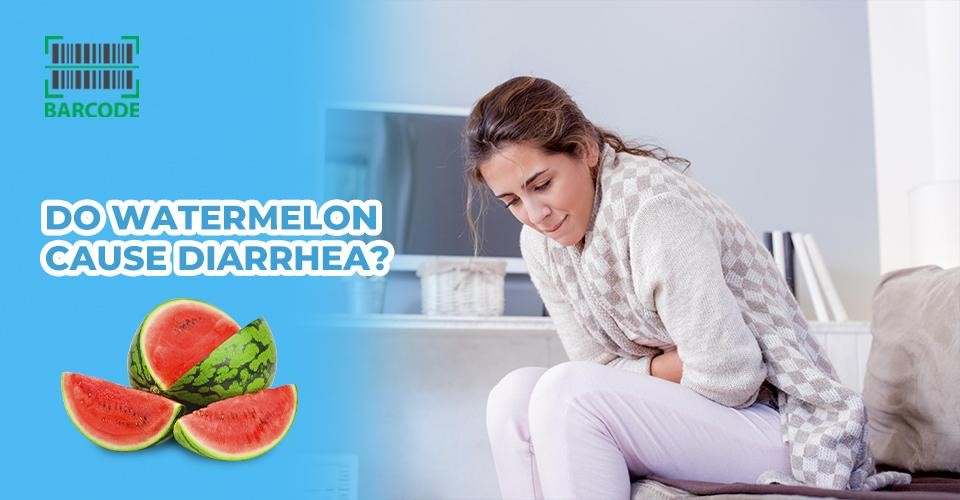What Heals Wounds The Fastest? Check Out These 7 Effective Ways
Waiting for a wound to heal can be very frustrating, whether or not it is a minor, acute, or chronic wound. So, what heals wounds the fastest?
In this post, you’ll find the best tips on how to heal your wound fast and get back to living your life to the fullest soon.
Let’s get started!

The fastest way to heal wounds
Do Wounds Heal Faster Covered or Uncovered?
According to experts, it is a huge mistake to expose a wound to the air so it can breathe because this produces a dry environment that encourages cell death.
Instead, numerous studies have shown that when wounds are left moist and covered, blood vessels regenerate more quickly, and the amount of inflammatory cells decreases more rapidly than when wounds are permitted to air out.
For at least five days, it is perfect for keeping a wound moist and covered.
What Are The Healing Stages Of Wounds?
Before getting into what's the fastest way to heal a wound, it’s important to learn about wound healing phases.
There are four main phases of wound healing: hemostasis, inflammation, proliferation, and remodeling.

Four phases of wound healing
Hemostasis
Hemostasis is the first step in healing a wound, which can take up to two days. This step starts as soon as the wound is made and involves stopping the bleeding.
The blood vessels in the injured area get smaller, which slows the flow of blood.
Next, platelets gather together and form a clot to close the wound. The blood clot stops blood from leaking out of the broken blood vessels by acting as a seal.
Inflammation
In most cases, this phase lasts up to seven days for new wounds and longer for old wounds.
During this phase, immune cells and some enzymes move to the wound area to fight infection and clean up bacteria and other debris.
Immune cells send out chemicals called cytokines, which speed up the next step of healing.
Inflammation or redness in the wound area, swelling, heat, and pain are all signs of this phase.
Proliferation
This stage includes the development of granulation tissue, angiogenesis (the creation of blood vessels), wound contraction, and epithelialization.
Collagen, the building block of the new tissue, is produced by fibroblasts, and blood vessels expand to supply the region with oxygen as well as nutrients.

The proliferative phase of wound healing
Due to the presence of inflammatory agents, the new tissue typically has a red or pink look.
The amount of time it takes for tissue to regenerate is based on how quickly fibroblasts produce collagen proteins. It may last four days, three weeks, or longer.
Remodeling (Maturation)
Depending on the original severity of the wound, this last stage may last for several months or even years.
It entails strengthening and remodeling new tissue. The reorganization and cross-linking of collagen fibers improve the tensile strength and elasticity of the epidermis.
It's possible that the wound will never regain its previous strength, but it should be able to endure typical strains and stresses.
What Heals Wounds The Fastest?
How to heal deep cuts fast? Well, there are many variables that affect how long it takes for a wound to heal, including the size, depth, and location of the incision, as well as the patient's general health and immune system.
However, there are a variety of things that can facilitate quicker wound healing and hasten the recovery process.
Clean your wound
Proper wound cleaning is important for avoiding infection and hastening the healing process in the event of a wound.
The dirt can be removed by carefully rinsing the wound with cold running water and then washing your hands with soap.
Use a syringe to flush the incision with water if it is particularly deep. Use sterile tweezers to clear any debris from the wound.
Use sterile gauze or a clean cloth to pat the wound dry.
Use topical antibiotics
When an infection sets in, the healing process for wounds and scrapes is much slower than when they are kept clean and free of germs.
Using a topical antibiotic is a great method to treat infection and speed up the healing process. Which cream is best for wound healing? Consider using Boro Plus Boroplus Antiseptic Cream, 40Ml, which can give your skin healthy protection.
However, overuse of antibiotics can result in drug resistance, so it's crucial to follow a doctor's orders when taking antibiotics.

Using topical antibiotics to speed up wound healing
Cover the cut or scrape
Protect the wound from dirt and germs by applying a sterile dressing after it has been cleaned and dried.
You can either use tape or a bandage to secure the patch. This makes for a moist, healing atmosphere free of grime and germs.
Sleep
A good night's sleep is essential for wound recovery. The body repairs damaged cells and mount an immune response to infections while you sleep.
The third and fourth phases of sleep, during which tissue growth and proliferation occur, account for 70 percent of a full night's sleep.
Thus, improved tissue development is directly proportional to the number of hours of undisturbed sleep.
In order to heal more quickly and effectively, you should try to slumber for at least eight hours every night.

Sleep helps your wound heal faster
Diet
A healthy immune system can be supported by eating nutrient- and vitamin-rich meals.
Anti-inflammatory foods like peppers, broccoli and mushrooms can also aid in the battle against infection.
Also, foods rich in antioxidants and important nutrients (such as vitamins A, C, K, calcium, and iron) have been shown to hasten the healing process of wounds.
Stay away from foods that contain nitrates, spices, and artificial sugars because they can cause your body to become inflammatory.
Apply black seed oil
Believe it or not, applying black seed oil can speed up wound healing, particularly when combined with honey.
According to many studies, the oil helped to increase the production of collagen, the rate of wound closure, and reduce inflammation in the wounds.

Using black seed oil helps wounds heal faster
Apply honey
It’s true! Honey has long been used as a home remedy for wound recovery.
It has antioxidant, anti-inflammatory, and antimicrobial qualities that can aid in promoting recovery and preventing infection.
According to a study published in the International Journal of Lower Extremity Wounds, honey helps burn patients experience less discomfort, inflammation, and swelling around their wounds.
Use only medical-grade honey that has been sterilized and processed to guarantee its purity and potency when applying honey to wounds.
When To See Your Doctor?
Visit your doctor if you have the following signs:
-
Attack wounds from people, animals, or insects.
-
Unclean wounds that are contaminated with dirt, glass, and other contaminants.
-
A difficult-looking deep open laceration that needs to be stitched.
-
Bleeding profusely from the wound despite sustained pressure.
-
Wound with redness, swelling, and oozing.
-
Signs of infection such as fast heart rate, confusion, disorientation, high heart rate, fever, breathlessness, severe pain and clammy skin.

When should you visit the doctor for a wound?
For a quicker recovery, it is ideal to cover your wound.
Because most wounds require moisture to mend, airing them out is rarely a good idea.
A wound that is left exposed may dry out new surface cells, increasing discomfort or delaying healing.
Neosporin works well at avoiding infections in small cuts and scrapes, but it cannot treat all open wounds.
In reality, some medical experts advise against using Neosporin on specific wound types, such as puncture wounds, animal bites, or deep cuts.
Moreover, not all wounds require antibiotics, and overusing them can result in drug resistance, a problem that is becoming increasingly important in contemporary medicine.
Therefore, it is always best to seek medical advice on the best course of therapy, which may or may not involve using Neosporin.
Several vitamins play an essential role in the body's wound-healing process. Here are some of the critical vitamins that can help you heal faster:
Vitamin A: encourages the growth of collagen and new skin cells, which can hasten the mending process.
Vitamin C: aids in the body's collagen production, a protein required for wound repair.
Vitamin E helps shield cells from the harm produced by free radicals.
Vitamin K: is crucial for blood clotting, which is necessary to halt bleeding and speed up the healing of wounds.
Bottom Line
You’ve learned what heals wounds the fastest with a reduced risk of scarring.
You will notice that the wound healing process is quicker and more efficient than ever before if you take the right care of your wound.


![9 Whey Protein Benefits For Your Health [Evidence Supported]](https://barcodelive.org/filemanager/data-images/imgs/20230213/News_9%20PROVEN%20Whey%20Protein%20Benefits%20At%20A%20Glance_1.jpg)
0 Comments
Leave a Comment
Your email address will not be published. Required fields are marked *